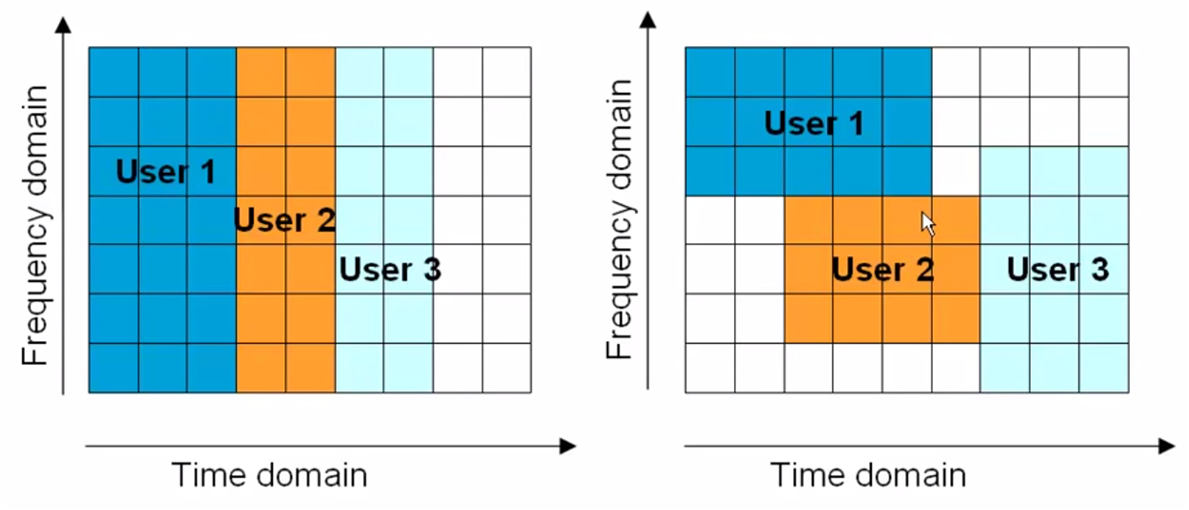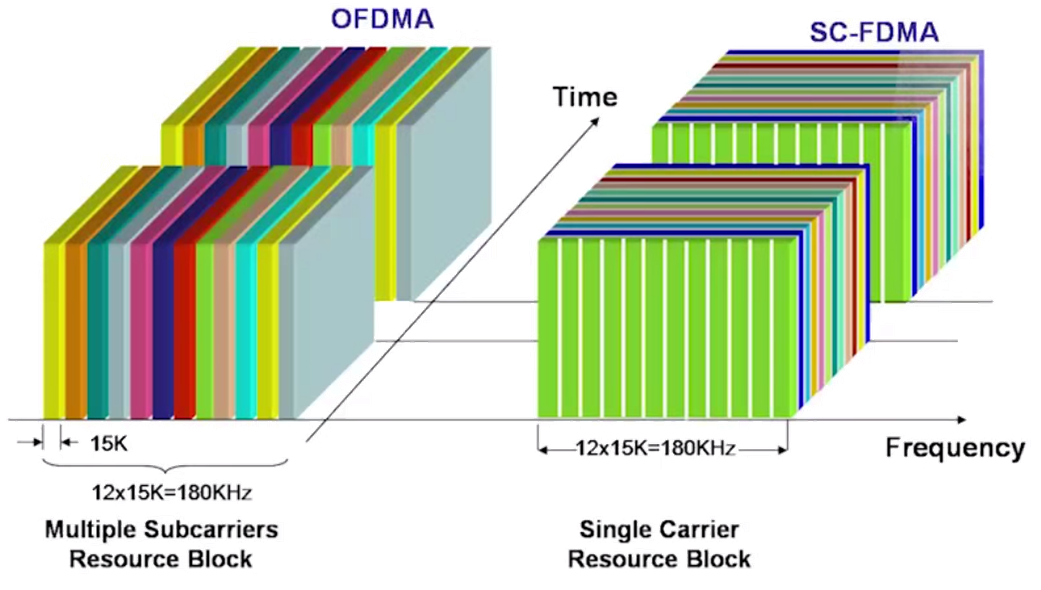OFDMA
In OFDM (Orthogonal Frequency Division Multiplexing) systems the original bandwidth is subdivided into multiple subcarriers. Each of this subcarriers can them be individually modulated. Typically in OFDM systems we can have hundreds of subcarriers with a content spacing between them (15KHz on the LTE case). Since the multiple subcarriers in OFDM are transmitted in parallel, it’s possible for each one to transmit with a lower symbol rate. That improves robustness on the technology for mobile propagation conditions.
The chain to generate an OFDM signal starts by paralyzing the symbols that need to be transmitted, after they are modulated (in LTE the modulation can be QPSK, 16AQM, 64QAM). Them they are used as input bands for an inverse fast Fourier transform operation. This operation produces OFDM symbols, which will be transmitted. Notice that a conversion from the frequency to the time domain was made when the IFFT was used. Before the transmission, however, a cyclic prefix is includes in the OFDM symbols in order to avoid intersymbol interference. This cyclic prefix in LTE has 5.2us on the first symbol, 4.7us for the rest of them and an extended cyclic prefix for larger cells.
On the receiving side of the OFDMA system we should expect an FFT operation that will them convert the symbol to the frequency domain again.
The main difference between an OFDM and an OFDMA (Orthogonal Frequency Division Multiple Access) system if the fact that in the OFDM the user are allocated on the time domain only while using an OFDMA system the user would be allocated by both time and frequency. This is useful for LTE since it makes possible to exploit frequency dependence scheduling. For instance, it would be possible to exploit the fact that user 1 might have a better radio link quality on some specific bandwidth area of the available bandwidth.
 Figure: OFDM x OFDMA
OFDMA is used on the downling, but since it presents a high Peak-to-average Power Ratio it is not possible to use it on the uplink. For the uplink SC-FDMA will be used.
Figure: OFDM x OFDMA
OFDMA is used on the downling, but since it presents a high Peak-to-average Power Ratio it is not possible to use it on the uplink. For the uplink SC-FDMA will be used.
 Figure: OFDM x OFDMA
OFDMA is used on the downling, but since it presents a high Peak-to-average Power Ratio it is not possible to use it on the uplink. For the uplink SC-FDMA will be used.
Figure: OFDM x OFDMA
OFDMA is used on the downling, but since it presents a high Peak-to-average Power Ratio it is not possible to use it on the uplink. For the uplink SC-FDMA will be used.
SC-FDMA
It is not possible to use OFDMA on the uplink since, as told before, it presents a high Peak-to-average Power Ratio. SC-FDMA (Singe Carrier FDMA) presents the benefit of a single carrier multiplexing of having a lower Peak-to-average Power Ratio. On SC-FDMA before applying the IFFT the symbols are pre coded by a DFT (Discrete Fourier Transform). This way each subcarrier after de IFFT will contain part of each symbol. Looking to the figure bellow it is possible to see the difference between SC-FDMA and OFDMS. Also, it is possible to notice that the intersymbol interference will be reduced since all subcarriers on a period of time represent the same symbol.
 Figure: Simplified LTE Architecture
Figure: Simplified LTE Architecture
 Figure: Simplified LTE Architecture
Figure: Simplified LTE Architecture